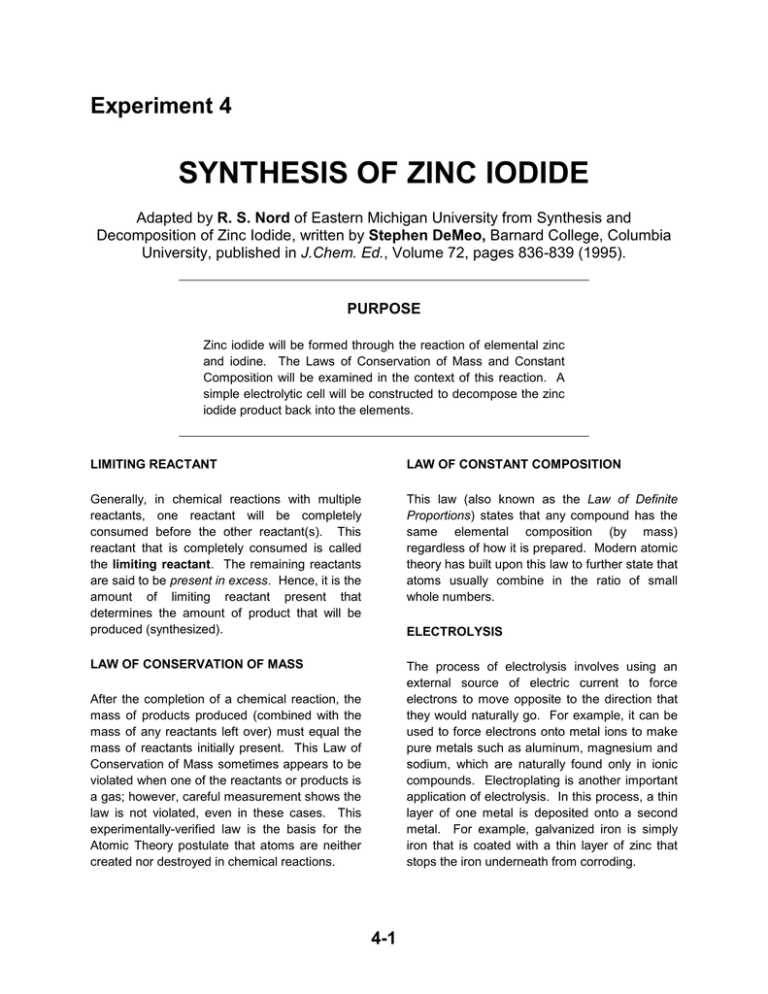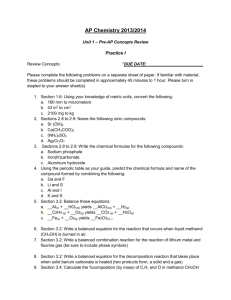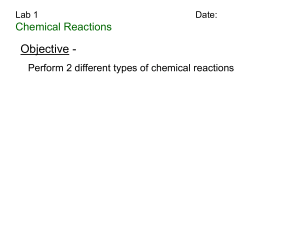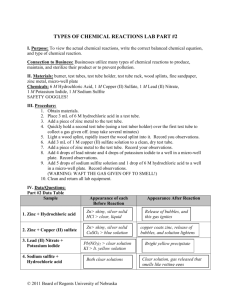SYNTHESIS OF ZINC IODIDE Experiment 4 R. S. Nord Stephen DeMeo,
advertisement

Experiment 4 SYNTHESIS OF ZINC IODIDE Adapted by R. S. Nord of Eastern Michigan University from Synthesis and Decomposition of Zinc Iodide, written by Stephen DeMeo, Barnard College, Columbia University, published in J.Chem. Ed., Volume 72, pages 836-839 (1995). PURPOSE Zinc iodide will be formed through the reaction of elemental zinc and iodine. The Laws of Conservation of Mass and Constant Composition will be examined in the context of this reaction. A simple electrolytic cell will be constructed to decompose the zinc iodide product back into the elements. LIMITING REACTANT LAW OF CONSTANT COMPOSITION Generally, in chemical reactions with multiple reactants, one reactant will be completely consumed before the other reactant(s). This reactant that is completely consumed is called the limiting reactant. The remaining reactants are said to be present in excess. Hence, it is the amount of limiting reactant present that determines the amount of product that will be produced (synthesized). This law (also known as the Law of Definite Proportions) states that any compound has the same elemental composition (by mass) regardless of how it is prepared. Modern atomic theory has built upon this law to further state that atoms usually combine in the ratio of small whole numbers. LAW OF CONSERVATION OF MASS The process of electrolysis involves using an external source of electric current to force electrons to move opposite to the direction that they would naturally go. For example, it can be used to force electrons onto metal ions to make pure metals such as aluminum, magnesium and sodium, which are naturally found only in ionic compounds. Electroplating is another important application of electrolysis. In this process, a thin layer of one metal is deposited onto a second metal. For example, galvanized iron is simply iron that is coated with a thin layer of zinc that stops the iron underneath from corroding. ELECTROLYSIS After the completion of a chemical reaction, the mass of products produced (combined with the mass of any reactants left over) must equal the mass of reactants initially present. This Law of Conservation of Mass sometimes appears to be violated when one of the reactants or products is a gas; however, careful measurement shows the law is not violated, even in these cases. This experimentally-verified law is the basis for the Atomic Theory postulate that atoms are neither created nor destroyed in chemical reactions. 4-1 Experiment 4 – Synthesis of Zinc Iodide IN THIS EXPERIMENT conservation of mass will be verified. Further, from the amounts of reactants consumed, the formula of zinc iodide can be determined and found to be a small whole number ratio (which is the same small whole number ratio found by everyone else who has ever made zinc iodide). Finally, the zinc iodide product will be dissolved in water, so it may undergo electrolysis to regenerate the reactants used to produce it. You will synthesize zinc iodide by mixing elemental zinc and iodine in water (which dissolves the zinc iodide product and allows the reaction to proceed at a much faster rate). You will observe which reactant is left over (not limiting). By weighing the amounts of chemicals before and after the reaction, the law of PRE-LABORATORY PREPARATION 1. Read the techniques, procedure and data analysis sections of the experiment. 2. Complete the computer-generated PRELAB assignment. Refer to the procedure and data analysis sections of the experiment as needed. The prelab questions for this experiment exactly replicate the questions in the data analysis section. EXPERIMENTAL SECTION REAGENTS PROVIDED WASTE DISPOSAL Zinc metal, Zn(s). 30 mesh (granular). Iodine, I2(s). Acetic Acid, 6 M. (M stands for molarity or moles per liter. Therefore, 6 moles of acetic acid are present in every liter of solution.) All liquids used in this experiment can be safely disposed of down the sink, followed by large amounts of water. The leftover solid zinc should be collected in a waste container in the hood. Hazardous Chemicals You will do this experiment individually or with a partner, as directed by your laboratory instructor. PROCEDURE Zinc metal -- possible irritant as a dust or powder. Do not inhale or swallow it and avoid skin contact. Iodine -- Corrosive. Avoid skin contact or breathing dust. Iodine vapors may be produced by heating iodine and are particularly hazardous. If you see purple vapor being produced, stop heating the sample immediately and place it in a hood. 6 M acetic acid -- corrosive and toxic. Avoid contact with your skin, eyes, and clothing. Keep the bottle capped to avoid inhaling any vapors. PREPARING THE REACTANTS 1. Clean and dry a 25x150 mm (large) test tube (we will call test tube A). Weigh it and record the mass on your data sheet (to the nearest 0.001 g). It is important that the test tube is completely dry before weighing it. Watch the test tube carefully to make sure that it does not roll off of the balance pan while you are weighing it. 2. With the test tube still on the balance, tare (zero) the balance. 4-2 Experiment 4 – Synthesis of Zinc Iodide 3. Remove the test tube from the balance and use a spatula to add solid iodine (roughly the size of a large pea) to the test tube. Replace the test tube on the balance to see how much iodine you obtained. Adjust until you have 0.5 g (0.1 g) of solid iodine in the test tube. Record the mass on your data sheet. It is not crucial that you weigh out exactly 0.5 g. However, you must know the exact mass. NEVER return chemicals to the bottle, since they may be contaminated. Either give extra to a friend or discard it down the drain. Be careful not to raise and breathe any dust as you measure out the iodine. Do not handle the iodine bottle with wet fingers or use a wet spatula. The iodine will make brown stains when it contacts a wet surface. Wash your hands if they come into contact with the iodine. Solid iodine is highly corrosive if it is spilled on a balance. This is why we remove the test tube from the balance before adding the iodine. If iodine is spilled, it should be swept up with a brush. Do NOT absorb it into a paper towel. A large beaker (250- or 400-mL) serves as a good “stand” for holding the test tube upright. 8. Add 2 or 3 drops of 6 M acetic acid to the water in the graduated cylinder and mix using a glass stirring rod. Set the stirring rod on a paper towel for later use. 9. Pour the contents of the graduated cylinder into the test tube contained the zinc and iodine. You should observe a color change as the iodine dissolves. The acetic acid was added to stop the formation of zinc hydroxide which will form if the water is too basic. It does not interfere with (or cause) the formation of the zinc iodide. 10. Swirl the contents of the test tube for a minute. Carefully feel the bottom of the test tube. Record your observations of color and temperature on your data sheet. Swirl vigorously, but not too vigorously. If the liquid splashes more than 2 inches up the side of the test tube, you are too vigorous. If it rises less than 1 inch, you are not swirling vigorously enough. 11. Continue swirling the test tube. The reaction is over when the solution becomes colorless (indicating all of the iodine has reacted). Further, all of the dark-colored iodine crystals must be gone. The total reaction time should be around 10 minutes. It is crucial that all of the iodine has reacted before continuing (as it is the limiting reactant). If you are not sure, consult the instructor or graduate assistant before continuing. If any of the brownish solution splashed up and formed spots on the side of the test tube, it must be washed down so that it reacts. To accomplish this, either tilt the test tube almost on its side so that the solution inside rinses the spot (being careful not to spill any liquid); or, spray as little distilled water as possible from a wash bottle to wash it down to the bottom. 4. Fold a piece of glassine weighing paper in half. Then open the paper, smooth it out and place it on a balance. Tare the balance. Creasing the paper creates a “spout” making it easier to pour the solid off of the paper. 5. Add approximately 0.5 g (0.1 g) of zinc metal to the paper using a clean, dry nickel spatula. Record the exact mass (to the nearest 0.001 g) on your data sheet. 6. Carefully pour the zinc metal into the test tube containing the iodine. The used glassine paper can go in the garbage. RUNNING THE REACTION While waiting for the reaction to go to completion, you can clean another test tube and prepare more dilute acetic acid as described in steps 12 - 14, below. 7. Clean and rinse out a 10-mL graduated cylinder with distilled water and then add 4 ( 0.5) mL of distilled water to it. 4-3 Experiment 4 – Synthesis of Zinc Iodide ISOLATING THE PRODUCT the residual zinc) over the flame to gently heat the test tube until it is dry. Read the next paragraph carefully before beginning! You should hold it so that the bottom of the test tube is about two inches over the flame. Typically, it is best to hold the test tube at a slight angle, as opposed to vertically straight up-anddown. WARNING: Never hold a test tube over a flame such that the open end of the test tube is pointed at yourself or any other person! Furthermore, you should continually move the test tube in a small circular pattern to achieve uniform heating. Once the zinc is dry, it will no longer clump together or adhere to the sides of the test tube. You can very lightly tap the bottom of the test tube on the counter top to see if the zinc metal is still sticking together. Once the zinc is dry, be sure to remove all of the water droplets that condensed on the sides of the test tube. This can be achieved by very slowly moving the test tube so that the Bunsen burner flame works its way from the bottom to the top (trying not to overly heat the metal test tube clamp you are holding). You may need to repeat this maneuver tilting the test tube so that the other side of it is down close to the flame. 12. Clean a second 25x150 mm test tube (test tube B). Rinse it with distilled water and dry thoroughly. Another large beaker can be used as a stand for this test tube. 13. Add three (or more) boiling chips to test tube B. Measure and record the combined mass of test tube B and the boiling chips. 14. Add about 5 mL of distilled water to the same 10-mL graduated cylinder used earlier. Add 3 drops of 6 M acetic acid to this water and mix using your glass stirring rod. 15. After the reaction in test tube A is complete, decant (pour) the liquid from test tube A into test tube B. Be careful not to transfer any of the residual solid (zinc). You should easily be able to see that the leftover solid looks like the zinc starting material and not like the iodine (which was all consumed in the reaction – the limiting reactant). 16. Add about 1-2 mL of acidified water from the graduated cylinder into test tube A to rinse the residual zinc. Swirl the contents for 5 seconds and then pour the liquid into test tube B. Again, be careful not to transfer any of the solid into test tube B. 19. Allow test tube A to cool down to room temperature. Meanwhile, go on to step 20. The test tube is VERY hot. Do not touch it until it has cooled (in about 5 minutes)! 20. Heat test tube B, containing the liquid solution in the same manner, until the zinc iodide product is dry. Read all four paragraphs below before beginning! The solution should be heated gently at first (with the bottom of the test tube about two inches above the top of the burner). After the liquid has started to boil, the boiling chips should make a nice, rolling boil with no explosions. You can heat the solution fairly vigorously at this point (by lowering the bottom of the test tube further into the hot part of the flame). If the bubbling liquid starts rising more than half way up the test tube, you should quickly reduce the heat (raise the test tube). After a few minutes of vigorous boiling you will see that the liquid level has 17. Repeat the rinse procedure, done in the previous step, two more times (for a total of three rinses). Each time, pour the rinse liquid into test tube B. Use all of the remaining water from the graduated cylinder during the third rinse. The purpose of these rinses is to make sure that all of the solution (containing your zinc iodide product) gets transferred into test tube B. DRYING THE PRODUCTS 18. Light a Bunsen burner and use a test tube holder to hold test tube A (containing 4-4 Experiment 4 – Synthesis of Zinc Iodide ELECTROLYSIS OF THE ZINC IODIDE dropped considerably, at this point you should raise the test tube and slow down the heating rate so the solid does not spatter. It should take about 10 minutes to completely dry the product. The dried zinc iodide product will either be white, off-white, or a light yellow. If the product turns a dark yellow, you are heating it too much and the product is decomposing to produce iodine. This should not happen if you are continually moving the test tube over the flame. If you see dark yellow product forming OR any sign of purple iodine vapor, stop heating immediately. If the purple vapors are escaping the test tube, hold the test tube in a hood until the vapors are no longer being produced. Do not be alarmed if you hear cracking sounds during the final stages of heating. This is normal. The product initially crystallizes out of solution as a hydrate (a salt with water molecules trapped inside its structure). To completely dry the product, this water must be liberated and this is what causes the cracking noise. The product is not completely dry until the cracking noise stops and the product begins to turn off white or light yellow. As the final step, again, heat the sides of the test tube (from bottom to top) to remove any water droplets that condensed on the sides. Note that this part of the reaction is not quantitative. So don’t worry about transferring every drop of liquid or rinsing thoroughly. 24. Obtain a transformer and 2 copper wire electrodes from the front bench. 25. If the electrodes are not shiny, the bottom one inch of electrode should be sanded using the sandpaper available. (Wipe off the electrodes with a paper towel to remove the sanding dust.) Avoid cutting yourself on the electrode as you sand. Gently fold a piece of sandpaper in half (so the abrasive sides are on the inside). Hold the end of the wire electrode with one hand and the sandpaper in your other hand. Grab the middle of the electrode inside the folded sandpaper. Slide the sandpaper off of the end of the electrode. Repeat a couple of times. This motion ensures that you sand from the middle of the electrode towards the end, reducing the chance of poking yourself on the sharp end of the electrode. 26. Add 30 mL of distilled water to a clean 50-mL graduated cylinder. 21. Allow about 5 minutes for test tube B to cool down to room temperature. Meanwhile, you can perform steps 24-27. Once again, this test tube is VERY hot. Do not touch it until it has had sufficient time to cool down. However, we cannot let the product sit too long because it will absorb water from the atmosphere, reforming the hydrate (which will throw off our measured mass). 27. Add 5 drops of 6 M acetic acid to the liquid in the graduated cylinder and stir briefly. 28. After you have weighed test tube B (step 22), pour the liquid from the graduated cylinder into test tube B (which contains the boiling chips and zinc iodide). Stir for a minute (or two) with your glass stirring rod until all of the zinc iodide dissolves. The boiling chips will not dissolve. It is okay if the solution still looks a little foggy. 22. Weigh both of your dry test tubes. Record the mass of each to the nearest 0.001 g, as always. 29. Pour the liquid from test tube B into a clean 50-mL beaker. The boiling chips should not be transferred. Instead, dump them into the garbage can. 23. Discard your residual zinc in the appropriate waste container in the hood. 4-5 Experiment 4 – Synthesis of Zinc Iodide 30. With the transformer still unplugged, attach the two electrodes to the two clips on the transformer and place the electrodes in the beaker with your zinc iodide solution. The shiny (sanded) part of the electrode should be down in the solution. Be sure that the electrodes do NOT touch each other (it will short out the circuit). If necessary, you can either bend the tops of the electrodes to make “hooks” to put over the sides of the beaker OR you can hold the insulated wires with your fingers (without touching the metal clips or electrodes). You might see some slight bubbling during the electrolysis. This is due to some of the water decomposing and is not relevant to the reaction we are studying. 32. Unplug the transformer. Unclip each electrode (noting whether it was connected to the + or – lead), remove it from the solution, and examine it carefully. Record your observations on your data sheet. 33. Wipe off the electrodes with a paper towel to clean and dry them. Then sand them to remove any residue, wipe off any dust, and return them (and the transformer) to the front bench. 31. Note which electrode is the positive electrode (the wire leading to the clip has a white stripe on it). Plug in the transformer and observe what happens in the solution near each of the two electrodes over the span of about 30 seconds. Record these observations on your data sheet. If nothing happens, make sure that (1) both electrodes are partially submerged in the solution; and (2) the electrodes are still attached to the transformer clips. You also may need to reset the transformer by pushing down on the green stem (button) on the top of the transformer. (You should not need to push down very hard, if the switch has been tripped, it will press down easily.) If this does not help, get assistance from the instructor. 34. Pour the reaction solution down the drain, followed by lots of water (10-15 seconds worth). Use a brush and tap water to clean your glassware. Rinse it with distilled water and dry it before your returning it to your drawer. Return the transformer, electrodes, and large test tubes to the containers on the front bench where you found them. WASH YOUR HANDS BEFORE LEAVING LAB. 4-6 THOROUGHLY Experiment 4 – Synthesis of Zinc Iodide Name Station Used Partner Instructor/Day/Time Station Checked & Approved DATA SHEET Record data with the appropriate number of significant figures and the correct units. Preparing the Reactants Mass of empty test tube A: Mass of iodine added: Mass of zinc added: Running the Reaction Color of the reaction mixture after one minute: Temperature observation of the reaction mixture after one minute: Color observations as the reaction progressed: Isolating and Drying the Product Mass of test tube B and 3 boiling chips: Mass of dry test tube A and residual zinc: Mass of dry test tube B, 3 boiling chips, and zinc iodide product: 4-7 Experiment 4 – Synthesis of Zinc Iodide Electrolysis Observations in the liquid solution (note which electrode, + or -, the activity occurred near): Observations of the electrodes (note on which electrode, + or -, the observation was made): Answer the following questions (based upon your observations during the electrolysis process, which converts the product back into the reactants): 1. One of the electrolysis products forms in solution around one of the electrodes (as well as on that electrode). A dilute solution of zinc is colorless, but a dilute solution of iodine is yellow. Which of the original reactants was produced at this electrode? Visually, how can you tell? 2. The second electrolysis product adheres to the other electrode. produced at this electrode? Visually, how can you identify it? Which original reactant was 3. Given the charge of the electrode (+ or -) that had the zinc adhere to it, was the charge on zinc ion positive or negative? (Hint: what type of ion would be attracted to an electrode with that charge?) 4-8 Experiment 4 – Synthesis of Zinc Iodide DATA ANALYSIS All calculations must be clearly organized, make proper use of significant figures and include the units. 1. Complete the table below for the combination reaction (forming zinc iodide): Mass of Zinc (g) Mass of Iodine (g) Present Before the Reaction (mass of each that was added) 0 Leftover after the Reaction* Consumed During the Reaction (Initial amount – Leftover amount) *Calculate the mass of residual (leftover) zinc by subtracting the “mass of “empty test tube A” from the “mass of dry test tube A and residual zinc”. 2. Use the atomic weights (masses) of zinc (65.4 g/mol) and iodine (126.9 g/mol) to calculate the number of moles of each that were consumed during the reaction. Moles of Zn consumed __________________ Moles of I consumed __________________ 3. Divide each number of moles of reactant consumed by the smaller number of moles. Round your result to the nearest whole number ratio to obtain the empirical formula of zinc iodide. Empirical formula of zinc iodide _____________________ 4-9 Experiment 4 – Synthesis of Zinc Iodide 4. Write a balanced chemical equation for the formation of solid zinc iodide (with the formula determined above) from the reactants used. (Hints: when writing the formulas of the reactants, you should specify the naturally occurring state of each and the phase in which it was initially present. It would also be appropriate to write H2O and above the arrow to indicate the use of water and heat in carrying out the reaction process.) 5. Using the masses recorded on your data sheet for test tube B, determine the mass of zinc iodide produced. Mass of zinc iodide produced _____________________ 6. Determine the relative experimental percent deviation from the Law of Conservation of Mass. (Mass of Zn Consumed + Mass of I Consumed) – Mass of Zinc Iodide Produced % Deviation = x 100% Mass of Zinc Iodide Produced % Deviation ____________________ Before leaving lab, turn in the Data Sheet and the Data Analysis pages. 4-10





